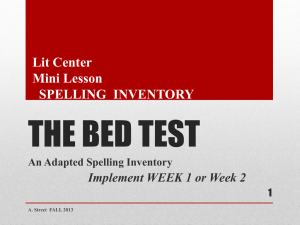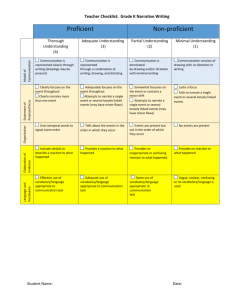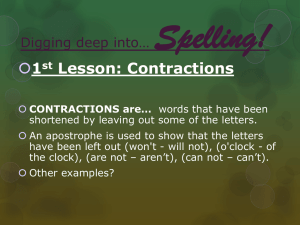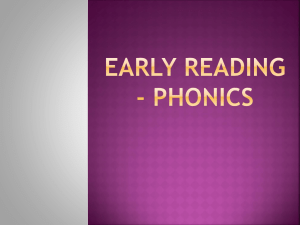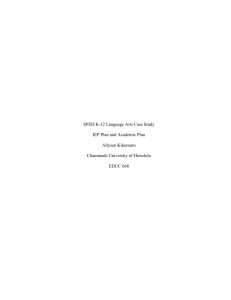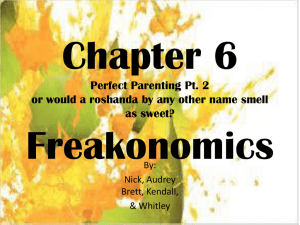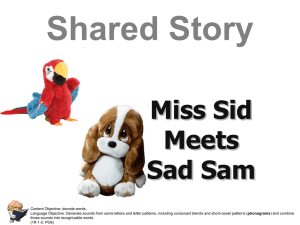Words_Their_Way__PowerPoint-1
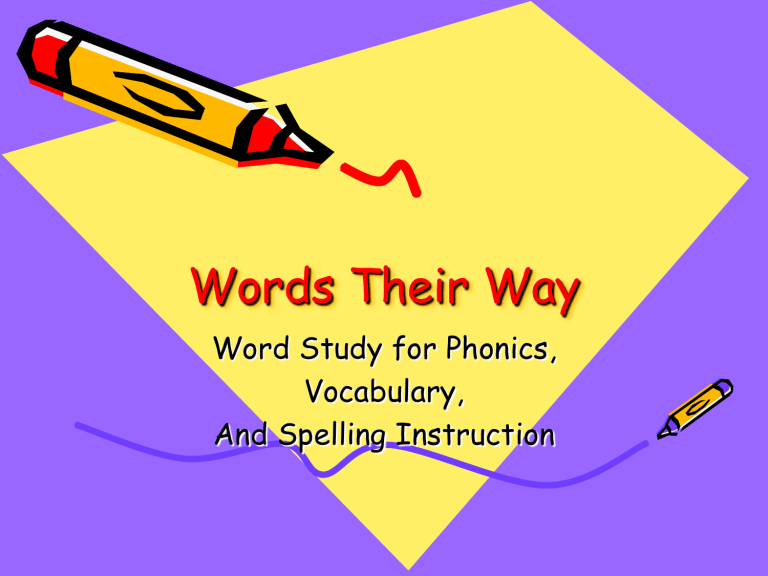
Words Their Way
Word Study for Phonics,
Vocabulary,
And Spelling Instruction
Developmental Reading
Stages
1. Emergent Stage
Characteristics:
• 1. Scribbles letters and numbers
• 2. Lacks concept of word
• 3. Lacks letter-sound correspondence or represents most salient sounds with single letters
• 4. Pretends to read and write
Emergent Stage
Reading and Writing
Activities
• 1. Read to students and encourage oral language activities
• 2. Model writing using dictations and charts
• 3. Encourage pretend reading and writing
Emergent Stage
Word Study Focus
• 1. Develop concept sorts
• 2. Play with speech sounds to develop phonological awareness
• 3. Plan alphabet activities
• 4. Sort pictures by beginning sound
• 5. Encourage finger point memory reading of rhymes, dictations, and simple pattern books
• 6. Encourage invented spelling
2. Early Letter Name-
Alphabetic Stage
Characteristics:
• 1. Represents beginning and ending sounds
• 2. Has rudimentary/ functional concept of word
• 3. Reads word by word in beginning reading materials
Letter Name-Alphabetic Stage
Reading and Writing Activities
• 1. Read to students and encourage oral language activities
• 2. Secure concept of word by plenty of reading in patterned trade books, dictations, and simple rhymes
• 3. Record and reread individual dictations one paragraph long
• 4. Label pictures and write in journals regularly
Letter Name – Alphabetic Stage
Word Study Focus
• 1. Collect known words for word bank
• 2. Sort pictures and words by beginning sounds
• 3. Study word families that share a common vowel
• 4. Study beginning consonant blends and digraphs
• 5. Encourage invented spelling
Middle to Late Letter
Name-Alphabetic Stage
Characteristics:
• 1. Correctly spells initial and final consonants and some blends and digraphs
• 2. Uses letter names to spell vowel sounds
• 3. Spells phonetically representing all salient sounds in a one-to-one linear fashion
• 4. Omits most silent letters
• 5. Omits pre-consonantal nasals in spelling
(Bop or Bup for bump)
• 6. Finger points and reads aloud
• 7. Reads slowly in a word-by-word manner
Middle to Late Letter Name-Alphabetic
Stage
Reading and Writing Activities
• 1. Read to students
• 2. Encourage invented spellings in independent writing but hold students accountable for features and words
• 3. Collect two-to-three-paragraph dictations which are reread regularly
• 4. Encourage more expansive writing and consider some simple editing such as punctuation and high frequency words
Middle to Late Letter Name-Alphabetic
Stage
Word Study Focus
• 1. Sort pictures and words by different short-vowel families
• 2. Sort pictures and words by short-vowel sounds and CVC patterns
• 3. Continue to examine consonant blends and digraphs
• 4. Begin simple sound sorts comparing short-and long-vowel sounds
• 5. Collect known words for word bank
(up to 200)
3. Within Word Pattern
Stage
Characteristics:
• 1. Spells most single-syllable short-vowel words correctly
• 2. Spells most beginning consonant digraphs and two-letter consonant blends
• 3. Attempts to use silent long-vowel markers (nale for nail)
• 4. Reads silently and with more fluency and expression
• 5. Writes more fluently and in extended fashion
• 6. Can revise and edit
Within Word Pattern Stage
Reading and Writing Activities
• 1. Continue to read aloud to students
• 2. Plan self-selected silent reading of simple chapter books
• 3. Write each day, writers ’ workshops, conferencing, and publication
Within Word Pattern Stage
Word Study Focus
• 1. Complete daily activities in word study notebook
• 2. Sort words by long-and short-vowel sounds and by common long-vowel patterns
• 3. Compare words with r-controlled vowels
• 4. After mastering common long vowels, explore less common vowels and diphthongs (oi,ou,au,ow)
• 5. Review blends and digraphs as needed and examine triple blends and complex consonant units such as thr, str, dge, tch,ck
• 6. Examine homographs and homophones
4. Syllables and Affixes
Characteristics:
• 1. Spells most single-syllable words correctly
• 2. Makes errors at syllable juncture and in unaccented syllables
• 3. Reads with good fluency and expression
• 4. Reads faster silently than orally
• 5. Writes responses that are sophisticated and critical
Syllables and Affixes Stage
Reading and Writing Activities
• 1. Plan read-alouds and literature discussions
• 2. Include self-selected or assigned silent reading of novels of different genres
• 3. Begin simple note taking and outlining skills, and work with adjusting reading rates for different purposes
• 4. Explore reading and writing styles and genres
Syllables and Affixes Stage
Word Study Focus
• 1. Examine consonant doubling and inflected endings
• 2. Focus on unaccented syllables such as er and le
• 3. Join spelling and vocabulary studies; link meaning and spelling
• 4. Explore grammar through word study
• 5. Sort and study affixes (prefixes and suffixes
• 6. Study stress or accent in two-syllable words
5. Derivational Relations
Stage
Characteristics:
• 1. Has mastered high frequency words
• 2. Makes errors on low frequency multisyllabic words derived from Latin and
Greek combining forms
• 3. Reads with good fluency and expression
• 4. Reads faster silently than orally
• 5. Writes responses that are sophisticated and critical
Derivational Relations Stage
Reading and Writing Activities
• 1. Include silent reading and writing, exploring various genres as interests arise
• 2. Develop study skills, including textbook reading, note taking, reading rates, test taking, report writing, and reference work
• 3. Focus on literary analysis
Derivational Relations Stage
Word Study Focus
• 1. Focus on words that students bring to word study from their reading and writing
• 2. Join spelling and vocabulary studies; link meaning and spelling
• 3. Examine common and then less common roots, prefixes, and suffixes
• 4. Examine vowel alternations in derivationally related pairs
• 5. Explore etymology, especially in the content areas
• 6. Examine content-related foreign borrowings
Primary Spelling
Inventory
Error Guide for Primary Spelling Inventory
